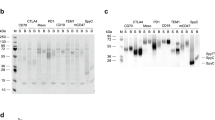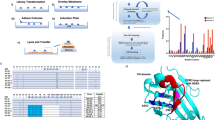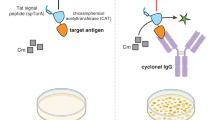Abstract
Intracellular expression of single-chain antibodies (scFvs) represents a promising approach for selective interference with cellular proto-oncogenes such as the epidermal growth factor receptor (EGFR). Previously, we have shown that intrabodies targeted to the lumen of the endoplasmic reticulum prevent the transit of EGFR or the related ErbB2 molecule to the cell surface, thereby inactivating their transforming potential. While intramolecular disulfide bridges important for antibody stability are correctly formed during expression in the secretory pathway, scFvs expressed in the reducing environment of the cytosol are often inactive. To overcome this problem and to generate antibody fragments that interact with the intracellular domain of human EGFR in the cytoplasm, here we have chosen a two-step approach combining classical selection of scFvs by phage display with subsequent expression in yeast. After enrichment of EGFR-specific antibody fragments from a combinatorial library by biopanning, a yeast two-hybrid screen was performed using the intracellular domain of EGFR as bait. Screening of 1.5 × 105 preselected scFv plasmids under highly stringent conditions yielded 223 colonies that represented at least five independent scFv clones functional in the intracellular milieu of eukaryotic cells. Interaction of selected antibody fragments with the intracellular domain of EGFR was confirmed in GST pull-down and coimmunoprecipitation experiments. Upon cytoplasmic expression in human tumor cells, scFvs colocalized with EGFR at the plasma membrane demonstrating their functionality in vivo.
This is a preview of subscription content, access via your institution
Access options
Subscribe to this journal
Receive 50 print issues and online access
$259.00 per year
only $5.18 per issue
Buy this article
- Purchase on Springer Link
- Instant access to full article PDF
Prices may be subject to local taxes which are calculated during checkout






Similar content being viewed by others
References
Altenschmidt U, Schmidt M, Groner B and Wels W . (1997). Int. J. Cancer, 73, 117–124.
Andris-Widhopf J, Steinberger P, Fuller R, Rader C and Barbas III CF . (2001). Phage Display: A Laboratory Manual. Barbas III CF, Burton DR, Scott JK and Silverman GJ (eds). Cold Spring Harbor Laboratory Press: Plainview, NY, pp. 9.1–9.113.
Bach H, Mazor Y, Shaky S, Shoham-Lev A, Berdichevsky Y, Gutnick DL and Benhar I . (2001). J. Mol. Biol., 312, 79–93.
Barbas III CF, Burton DR, Scott JK and Silverman GJ (2001). Phage Display: A Laboratory Manual. Cold Spring Harbor Laboratory Press: Plainview, NY.
Barbas III CF, Kang AS, Lerner RA and Benkovic SJ . (1991). Proc. Natl. Acad. Sci. USA, 88, 7978–7982.
Baselga J, Pfister D, Cooper MR, Cohen R, Burtness B, Bos M, D'Andrea G, Seidman A, Norton L, Gunnett K, Falcey J, Anderson V, Waksal H and Mendelsohn J . (2000). J. Clin. Oncol., 18, 904–914.
Beerli RR, Graus-Porta D, Woods-Cook K, Chen X, Yarden Y and Hynes NE (1995). Mol. Cell. Biol., 15, 6496–6505.
Beerli RR, Wels W and Hynes NE (1994a). Biochem. Biophys. Res. Commun., 204, 666–672.
Beerli RR, Wels W and Hynes NE (1994b). J. Biol. Chem., 269, 23931–23936.
Beerli RR, Wels W and Hynes NE (1996). Breast Cancer Res. Treat., 38, 11–17.
Biocca S, Pierandrei-Amaldi P, Campioni N and Cattaneo A . (1994). Biotechnology (NY), 12, 396–399.
Biocca S, Ruberti F, Tafani M, Pierandrei-Amaldi P and, Cattaneo A . (1995). Biotechnology (NY), 13, 1110–1115.
Cardinale A, Filesi I and Biocca S . (2001). Eur. J. Biochem., 268, 268–277.
Cattaneo A and Biocca S . (1999). Trends Biotechnol., 17, 115–121.
De Jaeger G, Fiers E, Eeckhout D and Depicker A . (2000). FEBS Lett., 467, 316–320.
Deshane J, Loechel F, Conry RM, Siegal GP, King CR and Curiel DT . (1994). Gene Ther., 1, 332–337.
Downward J, Yarden Y, Mayes E, Scrace G, Totty N, Stockwell P, Ullrich A, Schlessinger J and Waterfield MD . (1984). Nature, 307, 521–527.
Duan L, Bagasra O, Laughlin MA, Oakes JW and Pomerantz RJ . (1994). Proc. Natl. Acad. Sci. USA, 91, 5075–5079.
Gargano N and Cattaneo A . (1997). J. Gen. Virol., 78, 2591–2599.
Goncalves J, Silva F, Freitas-Vieira A, Santa-Marta M, Malho R, Yang X, Gabuzda D and Barbas III C (2002). J. Biol. Chem., 277, 32036–32045.
Graus-Porta D, Beerli RR, Daly JM and Hynes NE . (1997). EMBO J., 16, 1647–1655.
Gschwind A, Zwick E, Prenzel N, Leserer M and Ullrich A . (2001). Oncogene, 20, 1594–1600.
Gullick WJ . (1991). Br. Med. Bull., 47, 87–98.
Gullick WJ, Downward J and Waterfield MD (1985). EMBO J., 4, 2869–2877.
Hills D, Rowlinson-Busza G and Gullick WJ . (1995). Int. J. Cancer, 63, 537–543.
Holliger P, Prospero T and Winter G . (1993). Proc. Natl. Acad. Sci. USA, 90, 6444–6448.
Jannot CB, Beerli RR, Mason S, Gullick WJ and Hynes NE . (1996). Oncogene, 13, 275–282.
Jermutus L, Honegger A, Schwesinger F, Hanes J and Plückthun A . (2001). Proc. Natl. Acad. Sci. USA, 98, 75–80.
Kabat EA, Wu TT, Perry HM, Gottesman KS and Foeller C . (1991). Sequences of Proteins of Immunological Interest, 5 edn. National Institutes of Health: Bethesda.
Karunagaran D, Tzahar E, Beerli RR, Chen X, Graus-Porta D, Ratzkin BJ, Seger R, Hynes NE and Yarden Y . (1996). EMBO J., 15, 254–264.
Kile BT, Schulman BA, Alexander WS, Nicola NA, Martin HM and Hilton DJ . (2002). Trends Biochem. Sci., 27, 235–241.
King CR, Kraus MH and Aaronson SA . (1985). Science, 229, 974–976.
Klapper LN, Kirschbaum MH, Sela M and Yarden Y . (2000). Adv. Cancer Res., 77, 25–79.
Lener M, Horn IR, Cardinale A, Messina S, Nielsen UB, Rybak SM, Hoogenboom HR, Cattaneo A and Biocca S . (2000). Eur. J. Biochem., 267, 1196–1205.
Marasco WA . (1995). Immunotechnology, 1, 1–19.
Marasco WA . (1997). Gene Ther., 4, 11–15.
Martineau P, Jones P and Winter G . (1998). J. Mol. Biol., 280, 117–127.
Mendelsohn J . (1997). Clin. Cancer Res., 3, 2703–2707.
Mendelsohn J and Baselga J . (2000). Oncogene, 19, 6550–6565.
Mhashilkar AM, Bagley J, Chen SY, Szilvay AM, Helland DG and Marasco WA . (1995). EMBO J., 14, 1542–1551.
Ohage EC, Wirtz P, Barnikow J and Steipe B . (1999). J. Mol. Biol., 291, 1129–1134.
Olayioye MA, Neve RM, Lane HA and Hynes NE . (2000). EMBO J., 19, 3159–3167.
Parisien JP, Lau JF, Rodriguez JJ, Sullivan BM, Moscona A, Parks GD, Lamb RA and Horvath CM . (2001). Virology, 283, 230–239.
Persic L, Righi M, Roberts A, Hoogenboom HR, Cattaneo A and Bradbury A . (1997). Gene, 187, 1–8.
Proba K, Honegger A and Plückthun A . (1997). J. Mol. Biol., 265, 161–172.
Rader C and Barbas III CF (1997). Curr. Opin. Biotechnol., 8, 503–508.
Russo MW, Lukas TJ, Cohen S and Staros JV . (1985). J. Biol. Chem., 260, 5205–5208.
Shin DM, Donato NJ, Perez-Soler R, Shin HJ, Wu JY, Zhang P, Lawhorn K, Khuri FR, Glisson BS, Myers J, Clayman G, Pfister D, Falcey J, Waksal H, Mendelsohn J and Hong WK . (2001). Clin. Cancer Res., 7, 1204–1213.
Steinberger P, Andris-Widhopf J, Buhler B, Torbett BE and Barbas III CF (2000). Proc. Natl. Acad. Sci. USA, 97, 805–810.
Tse E, Lobato MN, Forster A, Tanaka T, Chung GT and Rabbitts TH . (2002). J. Mol. Biol., 317, 85–94.
Visintin M, Tse E, Axelson H, Rabbitts TH and Cattaneo A . (1999). Proc. Natl. Acad. Sci. USA, 96, 11723–11728.
Wörn A, Auf der Maur A, Escher D, Honegger A, Barberis A and Plückthun A . (2000). J. Biol. Chem., 275, 2795–2803.
Wörn A and Plückthun A . (1998). FEBS Lett., 427, 357–361.
Wörn A and Plückthun A . (2001). J. Mol. Biol., 305, 989–1010.
Xu JL and Davis MM . (2000). Immunity, 13, 37–45.
Yarden Y and Sliwkowski MX . (2001). Nat. Rev. Mol. Cell Biol., 2, 127–137.
Yi KS, Chung JH, Lee YH, Chung HG, Kim IJ, Suh BC, Kim E, Cocco L, Ryu SH and Suh PG . (2001). Oncogene, 20, 7954–7964.
Zhu Q, Zeng C, Huhalov A, Yao J, Turi TG, Danley D, Hynes T, Cong Y, DiMattia D, Kennedy S, Daumy G, Schaeffer E, Marasco WA and Huston JS . (1999). J. Immunol. Methods, 231, 207–222.
Acknowledgements
We thank Gesa Brochmann-Santos for excellent technical assistance during the initial phase of the project. This work was supported in part by grants to WW from the National Genome Research Network (NGFN) program of the German ‘Bundesministerium für Bildung, Wissenschaft, Forschung und Technologie’ (BMBF), and the German–Israeli Foundation for Scientific Research and Development. The laboratory of NEH is supported by the Novartis Forschungsstiftung Zweigniederlassung Friedrich Miescher Institute for Biomedical Research.
Author information
Authors and Affiliations
Corresponding author
Rights and permissions
About this article
Cite this article
Hyland, S., Beerli, R., Barbas, C. et al. Generation and functional characterization of intracellular antibodies interacting with the kinase domain of human EGF receptor. Oncogene 22, 1557–1567 (2003). https://doi.org/10.1038/sj.onc.1206299
Received:
Revised:
Accepted:
Published:
Issue Date:
DOI: https://doi.org/10.1038/sj.onc.1206299
Keywords
This article is cited by
-
Assembly and Folding Properties of Cytosolic IgG Intrabodies
Scientific Reports (2020)
-
Applying Antibodies Inside Cells: Principles and Recent Advances in Neurobiology, Virology and Oncology
BioDrugs (2020)
-
Intracellular human antibody fragments recognizing the VP35 protein of Zaire Ebola filovirus inhibit the protein activity
BMC Biotechnology (2019)
-
Engineering Antibodies
Journal of the Indian Institute of Science (2018)
-
Directing evolution: the next revolution in drug discovery?
Nature Reviews Drug Discovery (2017)



